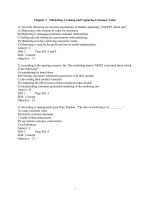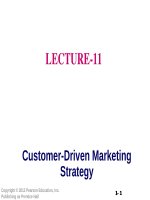Lecture fundamentals of marketing - Lecture 16: Pricing: Understanding and capturing customer Value
Bạn đang xem bản rút gọn của tài liệu. Xem và tải ngay bản đầy đủ của tài liệu tại đây (710.65 KB, 31 trang )
LECTURE16
Copyright © 2012 Pearson Education, Inc.
Publishing as Prentice Hall
11- 11
•
Topic Outline
§
What Is a Price?
§
Major Pricing Strategies
§
Other Internal and External
Considerations Affecting Price Decisions
Copyright © 2012 Pearson Education, Inc.
Publishing as Prentice Hall
1- 2
What Is a Price?
Price is the amount of money charged
for a product or service. It is the sum
of all the values that consumers give
up in order to gain the benefits of
having or using a product or service.
Price is the only element in the
marketing mix that produces revenue;
all other elements represent costs
Copyright © 2012 Pearson Education, Inc.
Publishing as Prentice Hall
1- 3
Major Pricing Strategies
•
Customer Value-Based Pricing
Understanding how
much value
consumers place on
the benefits they
receive from the
product and setting a
price that captures
that value
Copyright © 2012 Pearson Education, Inc.
Publishing as Prentice Hall
1- 4
Major Pricing Strategies
•
Customer Value-Based Pricing
Copyright © 2012 Pearson Education, Inc.
Publishing as Prentice Hall
1- 5
Major Pricing Strategies
Customer Value-Based Pricing
•
Value-based pricing uses the
buyers’ perceptions of value, not
the sellers cost, as the key to
pricing. Price is considered before
the marketing program is set.
§
Value-based pricing is customer
driven
Cost-based pricing is product
Copyright © 2012 Pearson Education, Inc.
driven
Publishing as Prentice
Hall
§
1- 6
Major Pricing Strategies
•
Customer Value-Based Pricing
Copyright © 2012 Pearson Education, Inc.
Publishing as Prentice Hall
1- 7
Major Pricing Strategies
•
Customer Value-Based Pricing
Good-value pricing
offers the right combination of quality and
good service at a fair price
Copyright © 2012 Pearson Education, Inc.
Publishing as Prentice Hall
1- 8
Major Pricing Strategies
•
Customer Value-Based Pricing
Everyday low pricing (EDLP) charging a
constant everyday low price with few
or no temporary price discounts
Copyright © 2012 Pearson Education, Inc.
Publishing as Prentice Hall
1- 9
Major Pricing Strategies
•
Customer Value-Based Pricing
High-low pricing charging higher prices
on an everyday basis but running
frequent promotions to lower prices
temporarily on selected items
Copyright © 2012 Pearson Education, Inc.
Publishing as Prentice Hall
1- 10
Major Pricing Strategies
•
§
Customer Value-Based Pricing
Value-added pricing attaches value-added
features and services to differentiate
offers, support higher prices, and build
pricing power
Copyright © 2012 Pearson Education, Inc.
Publishing as Prentice Hall
1- 11
Major Pricing Strategies
•
Cost-Based Pricing
Cost-based pricing setting prices based
on the costs for producing, distributing,
and selling the product plus a fair rate of
return for effort and risk.
Cost-based pricing adds a standard markup
to the cost of the product.
Copyright © 2012 Pearson Education, Inc.
Publishing as Prentice Hall
1- 12
Major Pricing Strategies
•
Cost-Based Pricing
Fixed costs are the costs that do
not vary with production or
sales level
–
Rent
–
Heat
–
Interest
–
Executive salaries
Copyright © 2012 Pearson Education, Inc.
Publishing as Prentice Hall
1- 13
Major Pricing Strategies
•
Cost-Based Pricing
Variable costs are the costs that vary with
the level of production
–
Packaging
–
Raw materials
Copyright © 2012 Pearson Education, Inc.
Publishing as Prentice Hall
1- 14
Major Pricing Strategies
•
Cost-Based Pricing
Total costs are the sum of the fixed and
variable costs for any given level of
production
Copyright © 2012 Pearson Education, Inc.
Publishing as Prentice Hall
1- 15
Major Pricing Strategies
•
Costs as a Function of Production
Experience
Copyright © 2012 Pearson Education, Inc.
Publishing as Prentice Hall
1- 16
Major Pricing Strategies
Costs as a Function of Production Experience
Experience or learning curve is when average
cost falls as production increases because fixed
costs are spread over more units
Copyright © 2012 Pearson Education, Inc.
Publishing as Prentice Hall
1- 17
Major Pricing Strategies
Cost-Plus Pricing
§
§
§
Cost-plus pricing adds a standard
markup to the cost of the product
Benefits
§
Sellers are certain about costs
§
Prices are similar in industry and price
competition is minimized
§
Buyers feel it is fair
Disadvantages
18
Ignores demand and competitor 1-prices
Copyright © 2012 Pearson
Education, Inc.
§
Publishing as Prentice Hall
Major Pricing Strategies
•
Break-Even Analysis and Target Profit Pricing
Break-even pricing is the price at which
total costs are equal to total revenue
and there is no profit
Target return pricing is the price at
which the firm will break even or
make the profit it’s seeking
Copyright © 2012 Pearson Education, Inc.
Publishing as Prentice Hall
1- 19
Major Pricing Strategies
•
§
§
Competition-based pricing
Setting prices based on competitors’
strategies, costs, prices, and market
offerings.
Consumers will base their judgments
of a product’s value on the prices that
competitors charge for similar
products.
Copyright © 2012 Pearson Education, Inc.
Publishing as Prentice Hall
1- 20
Considerations in Setting Price
Copyright © 2012 Pearson Education, Inc.
Publishing as Prentice Hall
1- 21
Other Internal and External
Considerations Affecting Price
Decisions
Target costing starts with an ideal selling
price based on consumer value
considerations and then targets costs
that will ensure that the price is met
Copyright © 2012 Pearson Education, Inc.
Publishing as Prentice Hall
1- 22
Other Internal and External
Considerations Affecting Price
Decisions
Organizational considerations include:
§
Who should set the price
§
Who can influence the prices
Copyright © 2012 Pearson Education, Inc.
Publishing as Prentice Hall
1- 23
Other Internal and External
Considerations Affecting Price
The Market and Demand
Decisions
•
§
Before setting prices, the marketer
must understand the relationship
between price and demand for its
products
Copyright © 2012 Pearson Education, Inc.
Publishing as Prentice Hall
1- 24
Other Internal and External
Consideration Affecting
Price Decisions
•
Competition
Copyright © 2012 Pearson Education, Inc.
Publishing as Prentice Hall
1- 25









